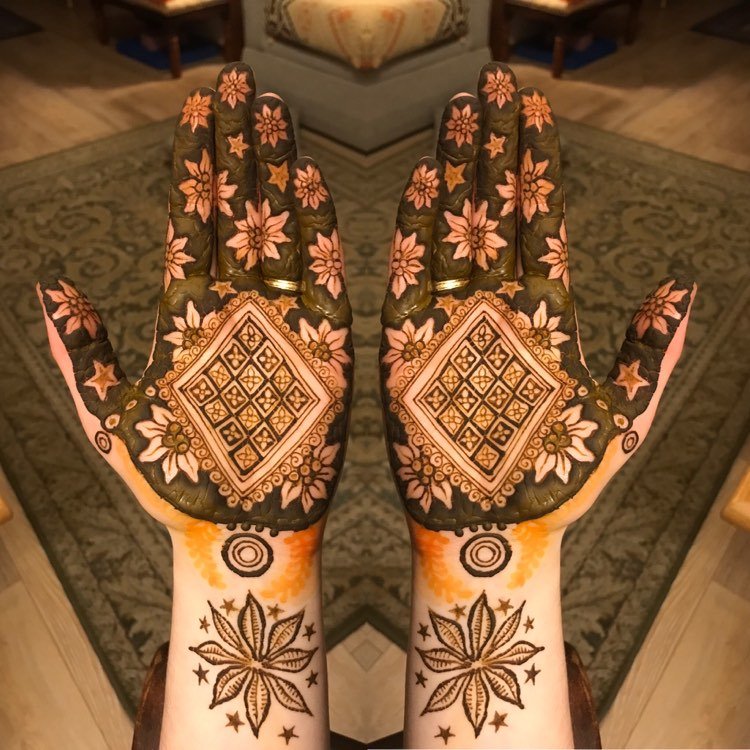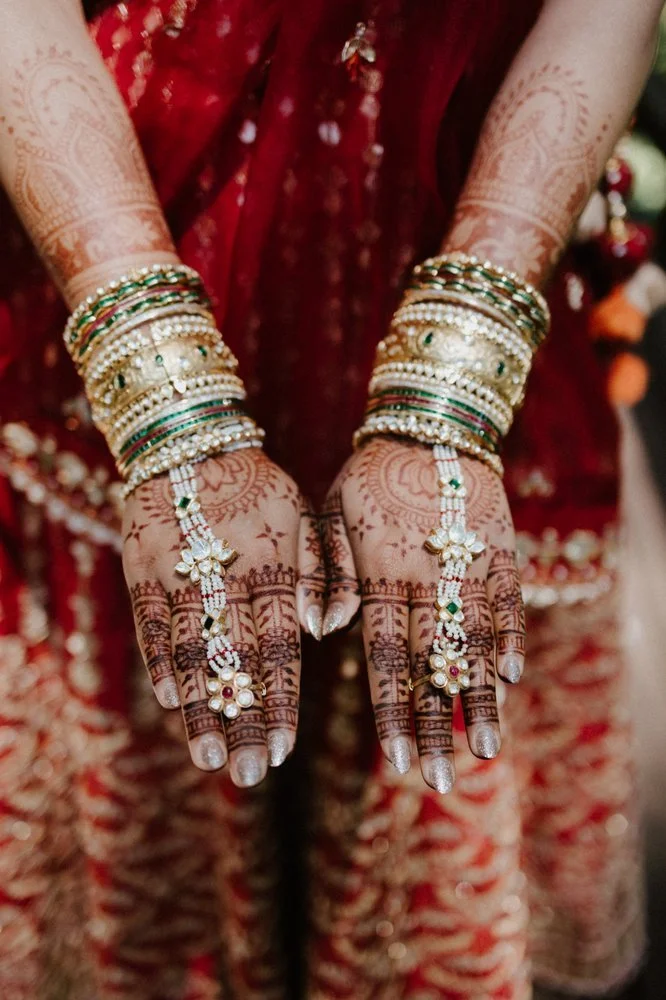My experience is a drop in the ocean of henna’s living history. Called so with the utmost reverence, I understand this adornment to be a folk art, the spirit of which lies in people rather than pages. Mine is one limited viewpoint among millions in a timeline of relationship that stretches back thousands of years, quite literally beyond recorded history. That being said, what follows is an incomplete history of henna and a bit about why I use it…
Let’s begin with the plant herself. This graceful, flowering, and thorny shrub is a veritable pharmacy in her own right whose dynamic healing properties have been employed medicinally for millennia. Knowledge of these uses are the result of the cumulative care and curiosity of those in the geographic regions including, but not limited to, North, South, Central, and East Africa, the Middle East, the Mediterranean, as well as South, Central, East, and Southeast Asia. Known by many names, this plant is a legendary traveller! From all parts of the plant (flowers, seeds, leaves, bark, and root) come medicines of astringent, anti-hemorrhagic, anti-microbial, anti-fungal, sedative, cardio-inhibiting, and abortifacient nature - to name a few. The stain from henna even acts as a UV resistant sunblock by colouring the epidermis which covers melanocytes (melanin producing cells) within the skin! My favourite practical example of this is the traditional use of henna paste on the pink noses of horses and other sweet creatures with light skin to protect them from sunburns. The legendary fragrant oil of her flower is also known to relieve muscular pains and headaches while the seeds can be used in deodorants and for regulating menstruation. The bark is even used to treat symptoms of jaundice and enlargement of the liver and spleen. We could go on and on…. Although I have scant experience using the plant for the aforementioned properties, I can corroborate the widely held belief that henna is the ultimate companion in a hot climate, or for just a hot head, because of its incredible cooling properties when applied as a paste. For this reason it is used by many to urgently and naturally reduce the temperature of a fever.
Returning to the living history of henna as a body adornment, I want to address in a very circuitous sort of way WHY henna is applied, especially since the meaning behind its application tends to be one of the first question asked! I reiterate that the knowledge presented here is limited - there are infinite answers to “why”, partially because the “why” depends on “who” which begs the question “where”, so let’s start there!
The earliest traceable remnants of henna from about 10,000 years ago indicate that Egypt is the likely originating land of this hardy, heat-loving perennial. From the remains of mummies, we can observe that the paste was used to colour, cleanse, and strengthen hair and nails which were susceptible to brittleness and fungal infection perhaps due to the climate and demands of daily life at the time. From that point it seems that trade, conquest, colonization, and diasporas in the ancient and medieval world carried the plant and traditions further on, rippling out from its point of origin, though the prime growing regions remained North/East/West Africa, the Middle East, Mediterranean, and warmer arid regions of South and Central Asia.
From the 10th century in what is now the occupied territories of Palestine, we begin to find allusions to henna in the erotic poetry of the Old Testament - yes, you read that right - known as the Song of Solomon or the Song of Songs which declares, “My Beloved is unto me as a cluster of henna in the vineyards of En-Gedi” (Song of Solomon, I, 14.) Henna cultivation and use spread thoroughly around the African continent through rich trading networks and thriving empires, accounts of which I would highly recommend diving into via the research of Noam Sienna (listed in citations). Further on, in Southeast Asia, court ladies in the palaces of 14th century Cambodia painted their feet with the precious plant paste while in China henna hand painting was introduced in the Western Jin Dynasty (266-400 CE) where it was known as fingernail flower. Meanwhile, in parts of medieval Europe, particularly Sicily and Spain, women across the Abrahamic religions (Islam, Judaism, and Christianity) would adorn themselves in henna in celebration of certain holy days. Whether in Persian miniature artwork, Greek pharmacopoeias, or paintings such as the Ajanta and Ellora caves of present-day India, one can find abundant examples in art history and literature which depict the reverence eras have held for this powerful plant.
The trajectory of henna has seen her flowing unconstrained by borders, religion, or gender, in her chameleon nature taking on the form and significance ascribed by the holder, wherever they may be. As a result, the world of henna is rich with visual vocabularies which can be very regionally or sociologically specific. For example, a Hindu bride may wear an extravagant application of henna depicting animals, portraits of the couple, or even gods and goddesses whereas in Islam the depiction of animate figures is haram (forbidden) so these type of designs would be avoided in favour of patterns and ornate arabesques. While some patterns are deeply symbolic, they can also be purely ornamental, as many whom I have met from traditional henna cultures expressed that they view it as simply another cosmetic, akin to having their hair done or getting a manicure. Similarly, a henna application need not be ornate - a simple circle in the palm of the hand, dipped fingers, or a henna “slipper” has long been deemed exquisite by many for its representation of freshness and purity!
Regardless of where in the world it is practised, the uniting thread in the ornate tapestry of cosmetic henna traditions seems to be that it is used in a spirit of celebration, cleansing, and auspiciousness for calling in blessings and protection of the wearer. Whether for weddings, holy days, pre and post-partum rituals, post-menstrual cleansing, circumcision rituals, honouring a memory or otherwise - it is a process and an adornment which demarcates all manner of transitions, endings, and beginnings.
A companion to the aesthetic allure of designs, and what to me is the essence of the henna plant, is that she is an enabler of connection between us and a medium for nurturing relationships. Between sisters, cousins, friends, aunties, mothers, brothers, or strangers, moments of adornment with henna can make for poignant and beautiful experiences. The act involves mind, body, and spirit, welcoming us to sit with another and connect in a meaningful and nourishing way. Personally, henna has brought me into relationship - be it sustained or brief - with a multitude of incredible people and for that I am eternally grateful! It has been my honour and privilege to share this plant in my own small way, adorning other bodies and my own with ornamentation that incites joy and celebrates externally the beauty of an inner journey. I feel fortunate that I was introduced to this art at such a young age and look forward to the future - all of the interactions, designs, and stories that are yet to be…
Thanks for reading, please find citations and links to wonderful information below.
Citations
Yang, Xue & Liu, Yu. (2020). Textual Research on Henna Art Introduced into Ancient China Through the Silk Road. Asian Social Science. 16. 21. 10.5539/ass.v16n9p21.
Li Q, Gao WQ, Zhao YQ. Advances in studies on chemical constituents and biological activities of Lawsonia inermis. Zhongguo Zhong Yao Za Zhi. 2013;38(6):795–9. doi: 10.1016/j.scitotenv.2014.03.119. [PubMed] [CrossRef] [Google Scholar]
Badoni Semwal R, Semwal DK, Combrinck S, Cartwright-Jones C, Viljoen A. Lawsonia inermis L. (henna): ethnobotanical, phytochemical and pharmacological aspects. J Ethnopharmacol. 2014;155(1):80–103. doi: 10.1016/j.jep.2014.05.042.
Noam Sienna Research - http://eshkolhakofer.blogspot.com/
Noam Sienna Research - http://www.hennabysienna.com/
Catherine Cartwright-Jones Research - http://www.hennapage.com/



